| DA NUMBERZ & DA CHARTZ |
The results of all of the benchmarking is summarized in the following table. Clockspeed settings are shown in parentheses (core/memory) below the card type. Each of the three cards has two sets of data. Results for the default clockspeed settings are on the left, and overclocked results on the right, for each card's pair of results:
 |
For each of the five benchmarks that were run, a chart of the results was generated, comparing the six video card/clockspeed combinations at each of the three benchmark conditions. To save space, small versions of each chart are shown below. Click on the chart of interest to open a larger, more easily read version:
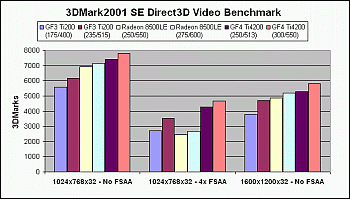 | 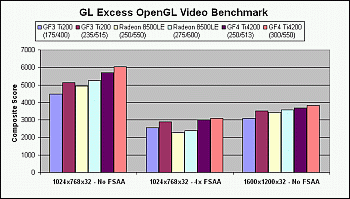 |
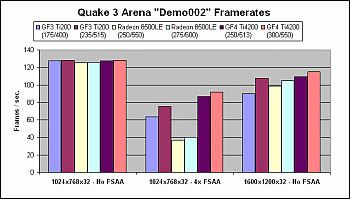 | 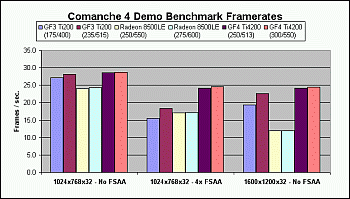 |
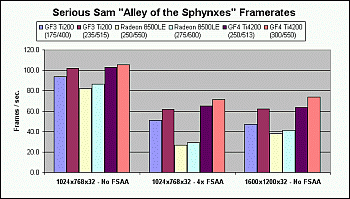 | |
| DISCUSSION, CONCLUSIONS & RECOMMENDATIONS |
Not surprisingly, the card with the newest technology--the Geforce4 Ti4200--dominated the test results, achieving the highest performance levels in all tests run. Of course, it's the most expensive of the three, as well. But the Geforce3 Ti200 and Radeon 8500LE made very respectable showings, and their low price is certainly a consideration. Of those two, I'd have to give the overall 3D performance nod to the Geforce3 Ti200, chiefly on the basis of its better showing under high resolution conditions and with 4x FSAA enabled.
I should mention, however, that the Radeon did show slightly better 2D sharpness and color saturation than the two Geforce cards. The difference was subtle, however, so it appears that NVidia has made progress in this area of historical weakness. The individual card makers choice of components has a big effect here, too, so maybe it's more of a reflection on Gainward than NVidia! It's also worth mentioning that ATI has long had the reputation for the finest DVD playback quality, and their software package includes their own DVD playback software, which leverages the card's onboard hardware decoding capabilities. So, if you're into DVD movies on your PC or output through an adjacent TV, the Radeon deserves an even closer look. By the way, I saw NO PROBLEMS with the Radeon drivers in any way. All the benchmarks ran well and looked fine.
As mentioned previously, I formulated the benchmarking plan to explore the impact that three commonly used features have on a given card's 3D performance: high resolution, full-scene anti-aliasing (FSAA) and overclocking. A couple of comments on the approach I took to assess the benchmark results for these three factors:
RESOLUTION: To assess resolution impact, I ran all tests at both 1024x768 and 1600x1200 screen resolutions (both at 32-bit color), looking at the performance drop incurred at the higher setting. I then calculated the percentage drop in the benchmark result for each test, and averaged those values to calculate an overall resolution impact value for each card.
ANTI-ALIASING: I took the same basic approach for anti-aliasing, running the 1024x768 resolution with no FSAA and with 4x FSAA enabled, and again observing how scores and frame rates dropped with the FSAA turned on. The overall anti-aliasing performance impact was calculated using the same method as described above for resolution.
OVERCLOCKING: I used a slightly different approach to assess the impact of overclocking. The complicating factor here was that each card was overclocked to a different degree. For example, the GF3 Ti200 comes with rather ridiculously low core and memory frequency settings, allowing them to be increased substantially before instability is seen. For my particular card, I overclocked the core by 34% and the memory by 29%--very substantial increases. For the Radeon, I didn't go through a full stability-based maximum overclocking exercise, but used the settings that many others had reported using successfully on the card: 275MHz on the core and 600MHz for the DDR memory. This amounted to a relative overclocking of only 10% and 9% respectively, even though the final clockspeeds are substantially higher than my GF3 Ti200 (235/515). For each card, I calculated the average increase in performance seen in all the benchmarks between the default and overclocked conditions. But because the degree of overclocking varied so much between the three cards (a factor of more than 3x), I also calculated the overclocking efficiency, normalizing the % performance gain by dividing it by the % overclock.
The results for the impact assessment of these three factors are summarized in the following table:
 |
As the table shows, the Geforce4 Ti4200 with it's more current technology incurs the smallest penalty from increasing resolution or turning on 4x FSAA. The Radeon is the worst of the three in this regard, particularly on FSAA, where an average performance penalty of nearly 60% was seen. ATI's inferior FSAA technology has been well documented in the past, so this is no surprise. Previews indicate that this problem is fixed in their upcoming "R300" cards, but if you're a gamer who likes to improve visual quality by cranking up the FSAA, the Radeon 8500LE may not be the best choice for you.
A couple of quick comments on another method of visual quality improvement that I did not assess in this study: anisotropic filtering (AF). This is a technique that can be used to sharpen the appearance of textures in 3D rendering, and is particularly effective when used in combination with FSAA, which tends to blur textures. While ATI's FSAA technology can't match NVidia's, the reverse is true with AF. ATI has developed a much more efficient algorithm for AF, allowing higher levels of filtering to be applied with very little negative performance impact. While even NVidia's poorer AF technology doesn't have anywhere near the frame rate penalty that FSAA typically imposes, ATI's performance advantage here deserves to be noted.
For overclocking, the situation is considerably different. Though the GF3 Ti200 is, by far, the best overclocker of the three, I consider this a misleading result, based upon how low its default clockspeeds are set. More indicative, I think, is the overclocking efficiency--the increase in 3D performance that you get per MHz of clock frequency increase. For this parameter, the three cards are very close, with the GF3 and Radeon a virtual "dead heat" at 52% and 53% respectively, and the GF4 close behind at 39%. It's kind of interesting that the older cards are the more efficient overclockers here.
A comment that I should make here is that I was disappointed at the extent to which the memory on the Gainward GF4 Ti4200 would overclock. Even though this is not one of their "Golden Sample" cards, Gainward specifies that 3.5ns memory is used, and I confirmed this by inspecting the printing on the memory chips. DDR memory rated at 3.5ns should run at 570MHz or better, but I found that anything above 550MHz would quickly lock up the PC. Maybe I just got a bad one, but it makes me suspicious that Gainward might be holding down cost by using "off-spec" memory on some of these cards. This was the only issue I had with what was otherwise an excellent card.
BOTTOM LINE: If you can afford the $150 or so that it takes to get into a GF4 Ti4200, that would be my clear recommendation among these three cards. IMO, the faster overall 3D rendering, better high resolution and FSAA performance, and newer technology are worth the extra $50, plus or minus, that you'll pay. But the good news is that if you only have $100 or so to plow into a video card upgrade, the Geforce3 Ti200 and Radeon 8500LE are still very viable options that offer solid overall performance. I'd lean toward the GF3 on a 3D performance basis, but the Radeon may make more sense for you based upon your individual needs. For example, it's the only card of these three with a DVI connector, though other, more expensive models of the two Geforce cards offer this feature, too. Keep an eye out for sales, because price could easily turn out to be the determining factor in choosing between these two cards.
Special Acknowledgement: I'd like to thank Larry "Pink" Pinkston for his generosity, which was a large factor in my purchase of the Gainward Geforce4 Ti4200 card. Thanks, Larry!! People like you make the DT forums what they are!
|
July 20, 2002
Questions or comments? E-mail me at THIS LINK |
|
